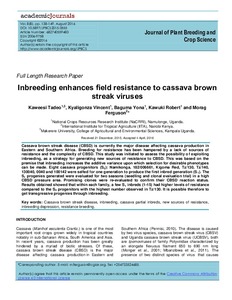| dc.contributor.author | Tadeo, K. |
| dc.contributor.author | Vincent, K. |
| dc.contributor.author | Yona, B. |
| dc.contributor.author | Robert, K. |
| dc.contributor.author | Ferguson, M. |
| dc.date.accessioned | 2019-12-04T11:03:37Z |
| dc.date.available | 2019-12-04T11:03:37Z |
| dc.date.issued | 2016-08-31 |
| dc.identifier.citation | Tadeo, K., Vincent, K., Yona, B., Robert, K. & Ferguson, M. (2016). Inbreeding enhances field resistance to cassava brown streak viruses. Journal of Plant Breeding and Crop Science, 8(8), 138-149. |
| dc.identifier.issn | 2006-9758 |
| dc.identifier.uri | https://hdl.handle.net/20.500.12478/1166 |
| dc.description.abstract | Cassava brown streak disease (CBSD) is currently the major disease affecting cassava production in Eastern and Southern Africa. Breeding for resistance has been hampered by a lack of sources of resistance and the complexity of CBSD. This study was initiated to assess the possibility of exploiting inbreeding, as a strategy for generating new sources of resistance to CBSD. This was based on the premise that inbreeding increases the additive variance upon which selection for desirable phenotypes can be made. Eight cassava progenitors (S0): Namikonga, 182/006661, Kigoma Red, Tz/130, Tz/140, 130040, 0040 and 100142 were selfed for one generation to produce the first inbred generation (S1). The S1 progenies generated were evaluated for two seasons (seedling and clonal evaluation trial) in a high CBSD pressure area. Promising clones were re-evaluated to confirm their CBSD reaction status. Results obtained showed that within each family, a few S1 inbreds (1-15) had higher levels of resistance compared to the S0 progenitors with the highest number observed in Tz/130. It is possible therefore to get transgressive progenies through inbreeding. |
| dc.format.extent | 138-149 |
| dc.language.iso | en |
| dc.subject | Cassava |
| dc.subject | Inbreeding |
| dc.subject | Inbreeding Depression |
| dc.title | Inbreeding enhances field resistance to cassava brown streak viruses |
| dc.type | Journal Article |
| dc.description.version | Peer Review |
| cg.contributor.crp | Roots, Tubers and Bananas |
| cg.contributor.affiliation | National Crops Resources Research Institute, Uganda |
| cg.contributor.affiliation | International Institute of Tropical Agriculture |
| cg.coverage.region | East Africa |
| cg.coverage.country | Tanzania |
| cg.coverage.country | Uganda |
| cg.authorship.types | CGIAR and developing country institute |
| cg.iitasubject | Cassava |
| cg.journal | Journal of Plant Breeding and Crop Science |
| cg.howpublished | Formally Published |
| cg.accessibilitystatus | Open Access |
| local.dspaceid | 78259 |
| cg.targetaudience | Scientists |
| cg.identifier.doi | https://dx.doi.org/10.5897/jpbcs2015.0555 |

